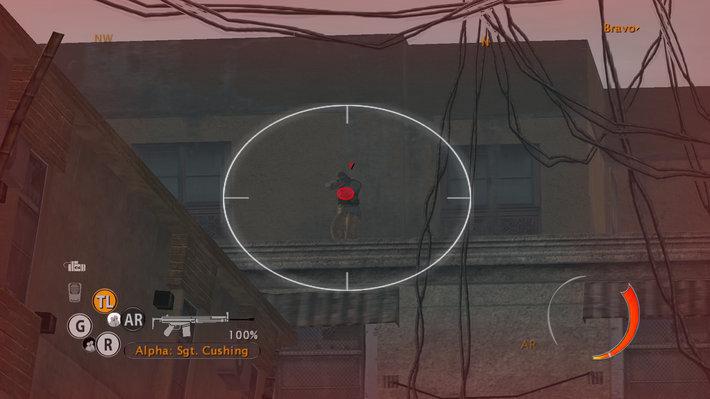You can trust VideoGamer. Our team of gaming experts spend hours testing and reviewing the latest games, to ensure you're reading the most comprehensive guide possible. Rest assured, all imagery and advice is unique and original. Check out how we test and review games here
As a series, Full Spectrum Warrior (FSW) holds a privileged position. Originally designed as a combat training simulator for American troops, it soon saw a commercial release. Needless to say, its simulator background gave it a level of credibility severely lacking in other squad-based combat games. FSW wasn’t an FPS but rather a real-time tactical action game where you indirectly controlled units of soldiers. You did no shooting yourself, but directed your men tactically and told them where and how to fire. In gaming terms it was relatively unique and Ten Hammers follows up on the success of its predecessor by sticking to the formula, albeit with a few extra features.
Ten Hammers starts out with the one of the least appealing FMV intros one cares to remember. It comes in the style of a news report from an embedded reporter following a new ‘rookie’ unit. The sequence introduces members of the team you’ll be controlling but ultimately you won’t care who they are, or what they do, as they reel off the usual tired old clichés. This is repeated later on and the whole storyline is so generic it is entirely inconsequential. Despite attempting some characterisation in these FMV intros, this doesn’t carry over into real-time gameplay, where those you control could be any old group of grunts. If you’ve come to expect and enjoy a more emotive style of game then this probably isn’t for you.
The opening mission doubles up as training and does a moderate job of it. As you progress you’ll be introduced to the controls and various combat situations, but expect to be frustrated early on. Ten Hammers is one of those games that fails to provide a good early impression; it throws a lot information at you and you’ll need to be concentrating to absorb it all. What really strikes you, though, is the sloppiness of the controls. The way they are mapped out isn’t a problem, it’s as well done as you could achieve on a standard controller, but there’s a severe lack of responsiveness. Once you spot an enemy it takes far too long to perform the necessary order in response to the situation. This often leads to the enemy getting the drop on you despite identifying the problem well in advance. For beginners a certain level of perseverance is a must.
The main area of concern, however, is the AI, which displays some wild inconsistency. Enemies will injure members of your team with regularity if even the smallest extremity pokes out of cover, yet, on the other hand, enemies will also vacate perfectly good cover for no particular reason, allowing them to be picked off with ease. Your allies don’t fare much better, with an annoying habit of failing to stay in cover and failing to pick off enemies in open positions. None of these are complete deal breakers but they occur often enough to annoy.
Once you do get over that initial frustration Ten Hammers delivers much the same experience as found in the original. Unlike other squad-based games, where you can often shoot your way out of trouble, Ten Hammers punishes you for elementary mistakes. Place your team(s) in an area without cover and they’ll be mowed down in double quick time. New features include some limited ability to control the actions of individual soldiers, new movement formations and the ability to direct several teams to the same location. In each four-man unit there’s a Team Leader, Automatic Rifleman, Grenadier and Rifleman, and each of them have different abilities which you can control. These are limited to specific actions so, for example, you can use the Rifleman to scout ahead or you can manually control the aim of any team member in precision fire mode. Another added feature is the ability to split your four-man team into two buddy teams. This provides another tactical angle to utilise, although you’ll have to weigh up the pros and cons of such a move. From time to time you’ll also get to call on mechanised units to provide further cover. Overall the new features add some nice variety to some already solid gameplay. If you’re looking for pure tactical combat then this is still the game for you.
Yet for all these virtues, the single-player campaign, spanning twelve substantial missions, feels relentlessly dull. The game does a poor job of setting up scenarios and level design is unimaginative. Rarely do you feel that what you are doing is of any real importance and the longer you play the less inclined you are to come back and finish the job. If you’ve had enough of the single-player campaign a number of online multiplayer modes are available. These can involve several factions on an objective-based map and can be quite fun, plus a versus mode is included for the first time in the series. They eliminate some of the vagaries of the AI, since you play against human opponents, but still suffer from the sloppy controls of the single-player mode.
From a technical standpoint Ten Hammers, much like the AI, suffers from a number of inconsistencies. The game world looks great, with some nice detail in the environments, but collision detection can falter and animations occasionally stutter. The one area it certainly excels in is sound, with meaty effects and a rousing musical score; the only complaint here being the rather repetitive nature of the in-game dialogue.
Ultimately Ten Hammers doesn’t build all that much on the original and is targeted at those hardcore strategists who truly enjoyed the first game. While the tactical combat is still the best around, more casual gamers hoping for a military action fix may find it too frustrating, too inconsistent and too cold for their liking.
Full Spectrum Warrior: Ten Hammers
- Platform(s): PC, PlayStation 2, Xbox
- Genre(s): Action, Simulation, Strategy







